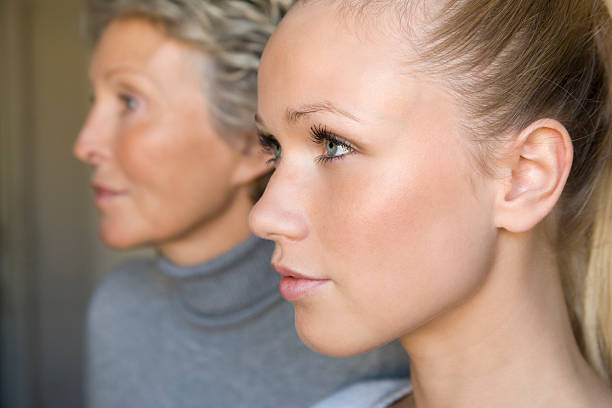Exploring the Impact of Disney Princesses and Villains on Perceptions of Female Aging.

B2M Productions/Getty Images
BY MACIE WILSON
Take a moment to close your eyes and picture a Disney princess.
Did your vision fit any of these characteristics?
- Youthful
- Petite
- Fresh-Faced
- Lustrous Hair
If they did fit your vision, you may be surprised to know that behind these ageless facades lies a deeper narrative that shapes our perceptions of femininity, aging, and beauty in ways we may not even realize.
Let’s go beyond the magic mirror and unveil how these beloved characters are redefining what it means to age gracefully and our perceptions of others. Keep reading, and let’s explore this enchanting world together!
The Myth of Eternal Youth & Shattering its Illusion

Disney
At Disney and other film companies, eternal youth is not just a concept; it is a fundamental fairytale narrative. Like many fairytale stories, this one too has more than meets the eye. Within these stories, princesses’ value often hinges on their idealistic appearance of youth. Changing the story for real-life women who face the fate of aging, the pressures of societal values, and the relentless pressure to stay young; the message is clear:
Aging is to be feared, avoided, and ultimately defeated at all costs.
Hidden among the shadows lurk Disney villains. In these animated stories, female villains are frequently portrayed with objectification and reductionism, their worth being measured by their outward appearance and actions rather than their inner complexity or character depth. Many of these villains have abnormal and deviant gendered characteristics, even some masculine physical traits, as suggested by Wellman. Furthermore, these characters commonly have physical characteristics that suggest extreme aging and decay. Villains are a stark contrast to their fresh faced, doe-eyed-foes. Depictions like this continue to reinforce societal fear and hatred for aging equating it with villainy and moral corruption. The dark shadow of aging in these movies perpetuates the harmful stereotypes associated with ageism and adds to societal pressures to resist and resent the natural process of aging.
Ageism finds a way to seep into our everyday life from many avenues like movies, advertisements, and music; the list is never ending. These only aid in boosting a thriving market for anti-aging products and practices. Women go to extreme ends to look young: the purchase of face creams and serums; procedures to plump the creases that adorn their faces; or alternating their bodies that have been affected by gravity, childbearing, or weight fluctuation. Clarke suggests that we will consistently bend to the social constructs around us. If we were a society that views older women as more beautiful compared to their younger counterparts, we would find ways to make ourselves look older. These portrayals can become a significant way that aging women are perceived by society and the narrative roles they are assigned to.
There is a disheartening parallel in real life where aging women often find themselves marginalized and overlooked. Despite the inevitability of aging, there’s often a lack of support and care for the health and well-being of older women, perpetuating the stigma and fear surrounding the aging process. When we dismiss these narratives as harmless fantasy, they contribute to the stigmatization of aging, particularly for women. It’s essential to recognize the harmful impact of these portrayals; as we begin to strive for more inclusive and empowering narratives that celebrate the richness and multifaceted nature of women’s experiences at all life stages.
If the glass slipper fell off, did it even fit in the first place?
Disney Villains Never Get Their ‘Happily-Ever-After.’
Disney
In these tales, female characters showcase an array of emotions, qualities, and traits. Disney princesses show compassion and determination, with some of them seeming passive or naive, reinforcing traditional gender roles. Additionally, princesses may rely heavily on male characters as sidekicks or the driving force behind their actions.
Disney villains, on the other hand, exhibit ambitious and bold traits, but lack compassion and act manipulatively towards others. They are conformed just so, making them the pivotal stereotype of evilness and revenge. In reality, older women frequently experience feelings of inferiority compared to their younger counterparts. They may receive fewer job opportunities, romantic partners, and overall opportunities, reflecting the vast impact of ageism on real life women. With this possible decline in social standing, it’s common for women to be overloaded with negative perceptions like dependency and irrelevance. Simone Hausknecht and colleagues suggested that asking someone how old they feel instead of how old they are could possibly measure how older adults form stereotypes about aging.
Furthermore, princesses and villains are created with narratives that pin aggression, anger, and a bitter rivalry to one another. Of eight movies noted in Wellman’s study (including: Snow White and the Seven Dwarves, Sleeping Beauty, The Little Mermaid, Cinderella, and Tangled), five of the movies contained villains who’s rivalry with a princess came from either the search for beauty or because they were jealous.
Could this be why we stand in the mirror with disgust at the sight of a single gray hair or because when we smile, our face creases and contorts. Have we just been subconsciously molded from our childhoods watching these films that aging is the villain in our own real-life fairy tales?
Magical Transformations: Empowering Women in Disney Narratives

Disney
We must continue to work at challenging stereotypes and recognizing the valuable contributions that people of all ages, sexualities, genders, and backgrounds make to society. Older individuals bring wisdom, experience, and unique perspectives that enrich communities and organizations. Promoting inclusivity and respecting individuals regardless of age can help combat ageism and foster a more supportive and inclusive society. By rejecting ageist stereotypes and amplifying diverse narratives, we pave the way for a culture that honors the inherent beauty and resilience of every woman, regardless of age.
This necessary change has begun for Disney, showcasing shows and films featuring diverse female characters like Moana and Raya, who break free from traditional molds, celebrate diversity, and challenge outdated stereotypes. These characters embark on self-driven epic journeys, emphasizing female friendships and highlighting their supportive bonds.
Disney’s efforts reflect a cultural shift towards inclusive representations of women, rewriting the narrative to encompass the beauty of aging and redefine societal values, fostering a culture that celebrates every woman’s worth. It is time that we pave the way for a culture that honors the inherent beauty and resilience of every woman, regardless of age. Together, let’s rewrite the narrative to embrace the beauty of aging and create a future where all women are valued and celebrated for who they are and what they have accomplished.
✨Happily Ever After✨
*Click*
[Add to Cart]

Additional Resources:
MacKinnon- Women, Aging and Visibility [TED TALK]
Get the Facts on Women and Aging (ncoa.org)
5 Healthy Aging Tips for Women | FDA
What Disney Villains Can Tell Us About Color Psychology- Blog
How Disney Uses Color to Communicate







